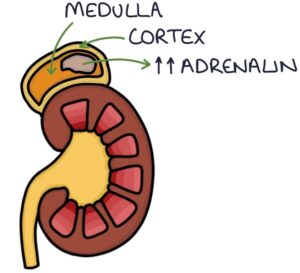A phaeochromocytoma is a tumour of the adrenal glands that secretes unregulated and excessive amounts of catecholamines (adrenaline).

Pathophysiology
Adrenaline is produced by the chromaffin cells in the medulla (middle part) of the adrenal glands. Adrenaline is a catecholamine hormone that stimulates the sympathetic nervous system and is responsible for the “fight or flight” response.
A phaeochromocytoma is a tumour of the chromaffin cells that secretes unregulated and excessive amounts of adrenaline. In patients with a phaeochromocytoma, the adrenaline tends to be secreted in bursts, giving intermittent symptoms.
Phaeochromocytomas are more common in certain genetic disorders:
- Multiple endocrine neoplasia type 2 (MEN 2)
- Neurofibromatosis type 1
- Von Hippel-Lindau disease
About 30-40% of patients have a genetic cause.
There is a 10% rule to describe the patterns of tumours:
- 10% bilateral
- 10% cancerous
- 10% outside the adrenal gland
Presentation
Signs and symptoms tend to fluctuate, relating to periods when the tumour is secreting adrenaline. Symptoms relate to excessive adrenaline:
- Anxiety
- Sweating
- Headache
- Tremor
- Palpitations
- Hypertension
- Tachycardia
Diagnosis
Initial tests include:
- Plasma free metanephrines
- 24-hour urine catecholamines
Measuring the serum catecholamine or adrenaline level is unreliable as the levels fluctuate and have a very short half-life of only a minute or so. Metanephrines (a breakdown product of adrenaline) have a longer half-life with more stable levels. Measuring 24-hour urine catecholamines gives an idea of how much adrenaline is being secreted by the tumour over 24 hours.
CT or MRI can be used to look for the tumour.
Genetic testing may be advised to look for a genetic cause (including relatives).
Management
Management involves:
- Alpha blockers (e.g., phenoxybenzamine or doxazosin)
- Beta blockers, only when established on alpha blockers
- Surgical removal of the tumour
Patients have their symptoms controlled medically before surgery to reduce the anaesthesia and surgery risks.
Last updated March 2023
Now, head over to members.zerotofinals.com and test your knowledge of this content. Testing yourself helps identify what you missed and strengthens your understanding and retention.

